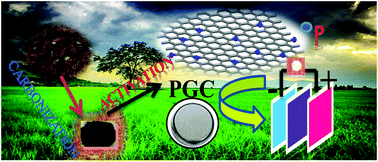Elaeocarpus tectorius derived phosphorus-doped carbon as an electrode material for an asymmetric supercapacitor†
Abstract
Phosphorus-doped porous carbon is prepared from a new biomass (Elaeocarpus tectorius) at three different temperatures using a facile H3PO4 activation approach. The physicochemical characterisation of the as-prepared carbons by X-ray diffraction, Raman spectroscopy, thermal analysis, scanning electron microscopy, N2 adsorption–desorption isotherms and X-ray photoelectron spectroscopy indicates that the carbon obtained at 900 °C possesses a high phosphorus content, 2.5% (by mass), and a large interlayer distance of the porous carbon with more expanded channels facilitating the penetration of ions into the interlayers and a rapid adsorption of ions suitable for ultra-high volumetric capacitance. The optimized carbon (900 °C) delivers high gravimetric capacitance (385 F g−1 at 0.2 A g−1) and volumetric capacitance (543 F cm−3 at 0.2 A g−1) in 1 M H2SO4. In 1 M Na2SO4 electrolyte, it still exhibits a gravimetric capacitance of 203 F g−1 at 0.3 A g−1 and a volumetric capacitance of 286 F cm−3 at 0.3 A g−1. Additionally, a coin cell asymmetric device fabricated using this carbon works in a wide potential window from 0 to 1.5 V with 96% capacitance retention in 1 M H2SO4 aqueous electrolyte for 1000 cycles and yields a high energy density of 27 W h kg−1, showing the utility for the development of wearable electronic devices.



 Please wait while we load your content...
Please wait while we load your content...